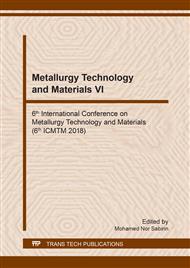[1]
Jin Y S, Jiang T, Yang Y B, et al. Removal of phosphorus from iron ores by chemical leaching. Journal of Central South University of Technology, 2006, 13(6): 673-677.
DOI: 10.1007/s11771-006-0003-y
Google Scholar
[2]
by hydrometallurgical process and leaching kinetics. ISIJ international, 2013, 53(12): 2056-(2064).
Google Scholar
[3]
Yu J T, Guo Z C, Tang H Q. Phosphorus removal from high phosphorus oolitic iron ore by acid leaching. Journal of University of Science and Technology Beijing, 2013, 35(8): 986-993 (in Chinese).
Google Scholar
[4]
Delvasto P, Valverde A, Ballester A, et al. Diversity and activity of phosphate bioleaching bacteria from a high-phosphorus iron ore. Hydrometallurgy, 2008, 92(3): 124-129.
DOI: 10.1016/j.hydromet.2008.02.007
Google Scholar
[5]
Yang D W, Sun T C, Yang H F, et al. Dephosphorization mechanism in a roasting process for direct reduction of high-phosphorus oolitic hematite in west Hubei Province, China. Journal of university of science and technology Beijing, 2010, 32(8): 968-974.
Google Scholar
[6]
Zhang Y, Li H, Yu X. Recovery of iron from cyanide tailings with reduction roasting–water leaching followed by magnetic separation. Journal of hazardous materials, 2012, 213: 167-174.
DOI: 10.1016/j.jhazmat.2012.01.076
Google Scholar
[7]
Matinde E, Hino M. Dephosphorization treatment of high phosphorus iron ore by pre-reduction, mechanical crushing and screening methods. ISIJ international, 2011, 51(2): 220-227.
DOI: 10.2355/isijinternational.51.220
Google Scholar
[8]
Nunes A P L, Pinto C L L, Valadão G E S, et al. Floatability studies of wavellite and preliminary results on phosphorus removal from a Brazilian iron ore by froth flotation. Minerals Engineering, 2012, 39: 206-212.
DOI: 10.1016/j.mineng.2012.06.004
Google Scholar
[9]
Pradhan N, Das B, Acharya S, et al. Removal of phosphorus from LD slag using heterotrophic bacteria. Minerals and Metallurgical Processing, 2004, 21(3): 149-152.
DOI: 10.1007/bf03403317
Google Scholar
[10]
Wang J C, Shen S B, Kang J H, et al. Effect of ore solid concentration on the bioleaching of phosphorus from high-phosphorus iron ores using indigenous sulfur-oxidizing bacteria from municipal wastewater. Process biochemistry, 2010, 45(10): 1624-1631.
DOI: 10.1016/j.procbio.2010.06.013
Google Scholar
[11]
Xia W T, Ren Z D, Gao Y F. Removal of phosphorus from high phosphorus iron ores by selective HCl leaching method. Journal of iron and steel research, international, 2011, 18(5): 1-4.
DOI: 10.1016/s1006-706x(11)60055-1
Google Scholar
[12]
Cheng C Y, Misra V N, Clough J, et al. Dephosphorisation of western Australian iron ore by hydrometallurgical process. Minerals Engineering, 1999, 12(9): 1083-1092.
DOI: 10.1016/s0892-6875(99)00093-x
Google Scholar
[13]
He L J, Zhou J M, Hu F R, at al. Characteristics of Meishan iron ore with high phosphrous- bearing and feasibility of biodephasphosorization. Gold Journal, 2000, 2(1): 26-29 (in Chinese).
Google Scholar
[14]
Huang J L, Yang Y M, Xie H. A study on the dephosphoriztion of iron ore by phosphorus dissolving agent accompanied with thiobacillus. Journal of Nanjing Forestry University, 1994, 18(2): 25-29 (in Chinese).
Google Scholar
[15]
Cui J R, Fang Q X. The present status and trends of dephosphorising of high phosphorus iron ore. Multipurpose Utilization of Mineral Resources, 1998, 6: 20-24 (in Chinese).
Google Scholar


